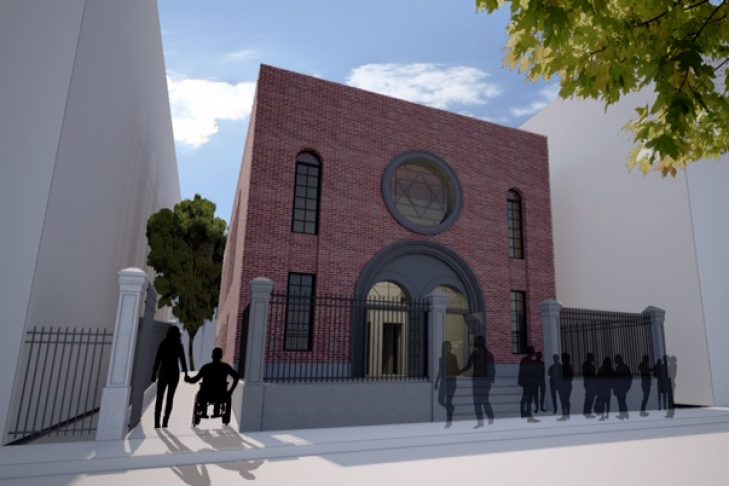An update on the status of the Vilna Shul’s renovation.
What’s the status of the renovation at The Vilna Shul?
The Vilna Shul, Boston’s last remaining immigrant-era synagogue building, has completed Phase I of our comprehensive building renovation project. This investment in our future is already providing significantly more ground floor space and flexibility for our ever-growing list of year-round programming and community events.
With thanks to our generous supporters, we raised $4 million for the design and renovation of this first phase of our building restoration project, which began in October 2018 and was completed in December 2019, during which time the building was closed. This allowed us to complete the excavation and reinforcement of the ground floor to create several multi-purpose rooms; add ADA-compliant restrooms and a lift to the second floor sanctuary; and a new, stairless main entrance and walkway on the side of the building.
We also made significant improvements to the ground-floor kitchen to support modern catering services while incorporating the building’s original stove. Other highlights of the project include restored woodwork on the community room bimah, new air conditioning and climate control and state-of-the-art A/V equipment throughout the building.
Why was it important to renovate the building, and why now?
The Vilna Shul is Boston’s last remaining immigration-era synagogue building, and this 21st-century upgrade is the first renovation since its construction 100 years ago.
Jewish immigrants from Vilnius, Lithuania, populated the north slope of Beacon Hill a century ago, ultimately establishing their place of worship at 18 Phillips St. The building served the booming Jewish community for decades, and it was among 40-50 synagogues active in this part of Boston. However, much of the West End was destroyed in the 1950s by an urban renewal project. The Vilna Shul was still standing, but as congregants left the area, the building fell into disrepair. Fast forward to 1995, when Vilna Shul purchased the condemned structure with the goal of fundraising to bring the building back to life. The Vilna Shul began serving as a community venue for concerts, speaker series, films and Jewish lifecycle events, but the building was in need of significant upgrades. By 2018, we had secured sufficient funds to embark on the long-awaited Phase I of renovation, leading us to today.
How has the renovation changed the way we use the building?
The Vilna Shul operates as a nonprofit cultural center and museum; a gathering place and educational resource for everyone. We welcome anyone who wants to learn about an important part of Boston’s immigrant history and understand how diverse cultures and faiths are connected across generations. The renovation ensures greatly improved accessibility and visitor comfort through 21st-century upgrades. Today we can offer a welcoming space that serves as a vibrant community hub, and we’ve already been able to host events that attract close to 300 attendees, with more planned for the months ahead.
What’s next?
Fundraising is currently underway for Phase II of the building’s renovation, which will focus on the extensive restoration of three distinct layers of folk art murals that were discovered in the upstairs sanctuary in 2006. The original bottom layer of paint dates back to 1920 and depicts scenes of Rachel’s Tomb and the Cave of the Patriarchs. The second and third layers of paint were added on top of the original layer, covering it completely, sometime in the late 1920s and ’30s. During the second phase of renovation, conservators will work to remove the top two layers of paint to restore the original 1920s artwork that was painted in the tradition of early 1800s-era Eastern Europe.
This phase will also include the refurbishment of the art and woodwork adorning the double front stairways, second floor landing and sanctuary, and the installation of motorized windows in the main sanctuary’s two skylights. A third fundraising initiative focused on establishing an endowment to ensure that the Vilna continues to enhance the Boston Jewish cultural landscape is planned after the building’s completion.
This post has been contributed by a third party. The opinions, facts and any media content are presented solely by the author, and JewishBoston assumes no responsibility for them. Want to add your voice to the conversation? Publish your own post here. MORE



